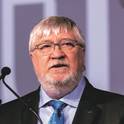This study investigates some effects of austenite microstructure on processes leading to copper hot shortness. Low carbon steels containing 0˙55 wt-% copper were subjected to two thermal profiles in an infrared image furnace with attached confocal scanning laser microscope: hold at 1150°C for 60 s; hold at 1150°C for 60 s, quench to 400°C, reheat to 1150°C. Heat treatments were conducted in dried/deoxidised argon to image microstructures. Subsequent samples were oxidised in air. The oxide/metal interface was studied in a scanning electron microscope. Additional confocal scanning laser microscope experiments involved melting copper directly on the steel. After quench/reheat, austenite grain size decreased by a factor of ∼1˙7 and grain boundaries were redistributed. Copper evolved during the first heating was no longer found at boundaries. Results from direct copper exposure reveal an apparent effect of boundary character on copper penetration rate. Possible mechanisms by which hot shortness is affected are discussed.
- High Residual Containing Steels,
- Copper,
- Surface Hot Shortness,
- Phase Transformation
Available at: http://works.bepress.com/ronald-omalley/34/
